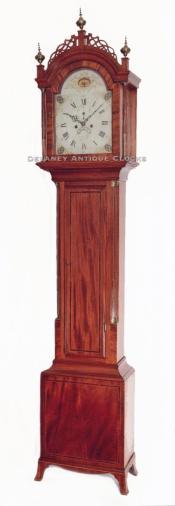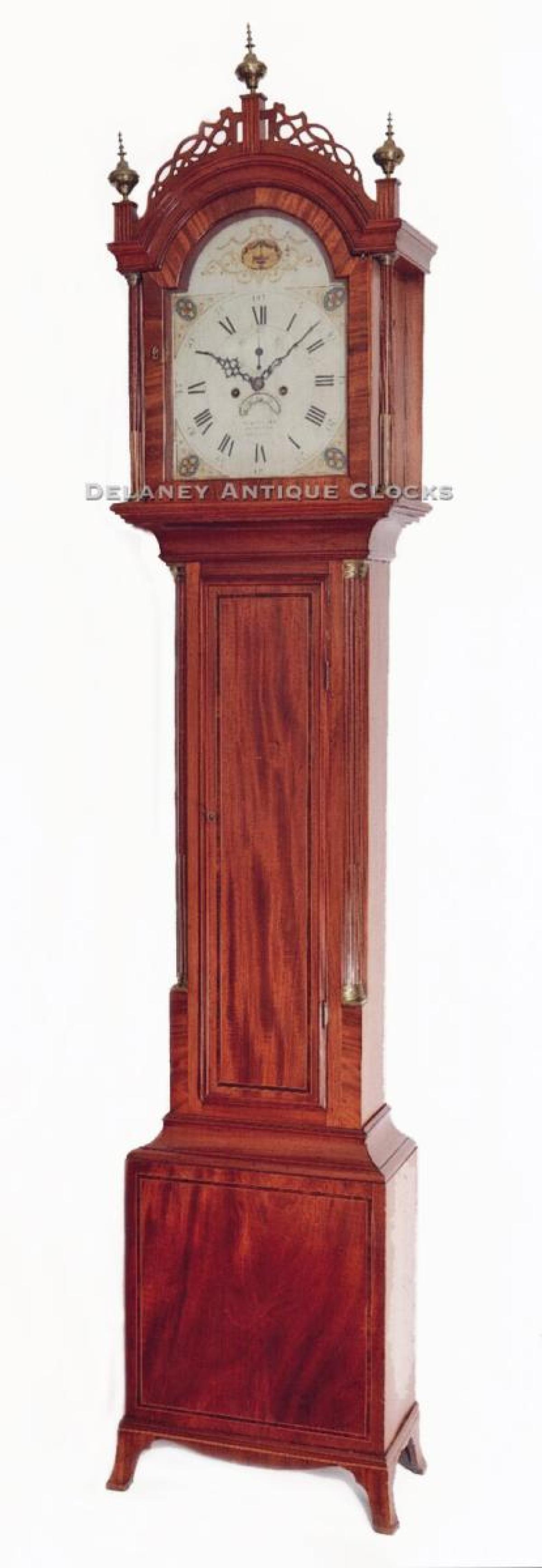Ephraim Willard of Boston, Massachusetts. A inlaid mahogany case tall clock. TT-109.
This is a fine example that exhibits excellent narrow proportions. The mahogany wood selected for the construction of this case is nicely figured and varies in coloration. The cabinet is alive.
This late example is elevated on an applied base. Four flared French-style feet splay out from under the base. These smoothly transition into the single-drop apron. A light line of wood inlaid is positioned on the top, just below the molding. The form is excellent. At the front of the case, follow the interior line as it transitions from one foot, bumping slightly at a small spur and then off to form the subtlety-shaped drop apron and along to the next foot. This is a lovely detail. A light line inlay runs across the bracket molding before it steps back to the base. The base panel is lined inlaid with a thin crass banded pattern of darker wood, framed with delicate, light wood inlay as a frame. The panel is well-formed and positioned in a vertical format.
Ephraim Willard of Boston, Massachusetts, made this inlaid mahogany case tall clock.
This is a fine example that exhibits excellent narrow proportions. The mahogany wood selected for the construction of this case is nicely figured and varies in coloration. The cabinet is alive with figure.
This late example is elevated on four applied French feet. The flared form is excellent. At the front of the case, follow the interior line as it transitions from one foot, bumping slightly at a small spur and then off to form the subtlety-shaped drop apron and along to the next foot. This is a lovely detail. A light line inlay runs across the bracket molding before it steps back to the base. The base panel is lined inlaid with a thin crass banded pattern of darker wood, framed with delicate, light wood inlay as a frame. The panel is well-formed and positioned in a vertical format.
The transition of the base into the waist section is with a flared molding. This middle section is long and relatively narrow and accentuates the pleasing form of the case. The rectangular-shaped waist door exhibits an excellent grain pattern. It is fitted with applied molding along its perimeter. This door is also lined inlaid in a design that conforms to the door shape. The sides of this case are fitted with fluted quarter columns that are stopped with brass and terminating in brass quarter capitals.
The waist section supports the hood section with a traditionally formed flared throat molding. This bonnet features a traditional pierced and open lacy fretwork design and is surmounted with three brass finials. Each of the finials is mounted on fluted plinths. The bonnet door is an arched form and is fitted with glass. The two smoothly turned and brass stop-fluted bonnet columns are positioned on either side of this door. They are free-standing and mounted into brass capitals. They provide the illusion of supporting the upper bonnet molding. Tombstone-shaped sidelights are fitted into the sides of the bonnet. Each of these is fitted with glass and provides a view of the mechanism.
The eight-day time and strike movement is brass and is of fine quality. It is designed to strike each hour on the hour. It strikes the hour a cast iron bell that is mounted above the movement. This clock is weight powered and wound with a key.
The iron dial is colorfully painted. Floral patterns decorate each of the four spandrel areas of this dial. The artwork in the lunette is very well done. An urn is centrally depicted in a window that is framed with curtains. Applied gesso beading and gilt work decorate the scene. This dial displays the time in a traditional format with large Roman-style numerals that mark the hours. Arabic numerals are positioned at the five-minute marker locations. A subsidiary seconds dial is located below the Roman hour numeral XII, and the calendar date is indicated below the center arbor. This dial is signed by the maker just below the calendar aperture. It reads “E. WILLARD / WARRANTED. / BOSTON.”
This clock was made while Ephraim lived in Boston before moving to New York. This would date to about 1804 and may have been one of the last clocks he made based on the styling of this case. It stands approximately 7 feet 11.5 inches tall to the top of the finial. It is approximately 19.5 inches wide and 9 inches deep.
This grandfather clock is inventory number TT-109.
Ephraim Willard was born in Grafton, Massachusetts, on March 18, 1755. His parents, Benjamin Willard and Sarah (Brooks) Willard, had twelve children. Four of the boys became clockmakers. Little is known of Ephraim's early life in Grafton, where he probably learned clock-making from his older brothers Benjamin and Simon. Simon Willard (1753-1848) was to become America's most famous clockmaker. Ephriam was also a clockmaker and most likely worked closely with Simon and Aaron. There is a notation in the History of the town of Sutton, Massachusetts, from 1704 to 1876, including Grafton until 1735; Millbury until 1813; and parts of Northbridge, Upton, and Auburn. This notation claims Ephriam's brother Simon was hired by Joseph Rockwell to construct a machine for cutting and crooking the teeth of a carding machine at the same time. It is recorded that Ephraim did march with his brothers in response to the Lexington Alarm on April 19, 1775. His service lasted all of one week and five days. In 1777, he took up residence in Medford, Massachusetts, and was listed as a clock and watchmaker. In 1784, a lawsuit identified him as a trader living in Boston. From 1795 through 1801, he is listed as a Roxbury resident in the Roxbury Tax Records. In 1801, he purchased land and a house on Sheaf's Lane in Boston. The deed for this transaction describes Ephraim as a "Merchant." Financial difficulties followed over the next two years, and Ephraim was described as a Clockmaker. In 1804, he is listed in the Boston Tax Records as a clockmaker on Elliot Street. In 1805 Ephraim moved to New York City and is listed occasionally as a watchmaker until 1832. Like his older brother Benjamin, Ephraim was a bit of a wanderer. His production as a Clockmaker was a fraction of what his three other brothers produced. A small number of tall clocks are known. The cases he selected to house his clocks range from simple and reserved to what is considered the best the Boston area cabinetmaker had to offer.












